
The Rumble Pak is a removable device from Nintendo which provides force feedback while playing video games. Games that support the Rumble Pak cause it to vibrate in select situations, such as when firing a weapon or receiving damage, to immerse the player in the game. Versions of the Rumble Pak are available for the Nintendo 64, the Nintendo DS, and the Nintendo DS Lite. A select few Game Boy Color and Game Boy Advance (GBA) games use a similar technology built into the game cartridge. Force feedback vibration has become a built-in standard feature in almost every home video game console controller since.
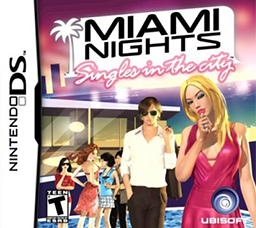
Miami Nights: Singles in the City is a dating simulation game for the J2ME Platform, Nintendo DS and BlackBerry. It is based on the successful Gameloft Nights franchise for mobile phones which has generated more than 4 million downloads.. The game is similar to New York Nights: Success in the City which is also a part of Gameloft's Nights series.

The Nintendo DSi is a dual-screen handheld game console released by Nintendo. The console launched in Japan on November 1, 2008, and worldwide beginning in April 2009. It is the third iteration of the Nintendo DS, and its primary market rival was Sony's PlayStation Portable (PSP). The fourth iteration, entitled Nintendo DSi XL, is a larger model that launched in Japan on November 21, 2009, and worldwide beginning in March 2010. Development of the DSi began in late 2006, and the handheld was unveiled during an October 2008 Nintendo conference in Tokyo. Consumer demand convinced Nintendo to produce a slimmer handheld with larger screens than the DS Lite. Consequently, Nintendo removed the Game Boy Advance (GBA) cartridge slot to improve portability without sacrificing durability.
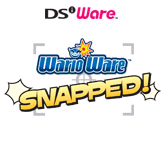
WarioWare: Snapped! is a minigame compilation party video game developed by Nintendo SPD Group No.1 and Intelligent Systems and published by Nintendo for the Nintendo DSi's DSiWare digital distribution service, and is part of the WarioWare series of video games. It is the sixth game in the series.

Need for Speed: Nitro is a racing video game and the fourteenth title of the Need for Speed series. It was published by Electronic Arts for the Wii and Nintendo DS platforms. It is also one of only two games in the franchise to date to not be made for PC and the only game of the franchise to be released only for Nintendo consoles. It was announced in January as part of a three-game announcement that includes Need for Speed: Shift and Need for Speed: World. The game was developed by EA Montreal who have previous experience with Nintendo titles, although the DS version was developed separately by Firebrand Games' Florida studio. An improved version of the DS edition of the game, Need for Speed: Nitro-X, was released for DSiWare on November 26, 2010.
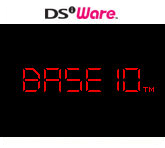
Code, known as Base 10 in North America and Decode in Japan, is a puzzle video game developed by Skip Ltd. and published by Nintendo for the Nintendo DSi's DSiWare digital distribution service.

Aquia, known as Aquite in Europe and Aquario in Japan, is a puzzle video game developed by Skip Ltd. and published by Nintendo for the Nintendo DSi's DSiWare digital distribution service. It was released at the launch of the Nintendo DSi and DSiWare service on April 5, 2009 in North America.

Art Style: Nemrem, known as Art Style: Zengage in North America and Art Style: Somnium in Japan, is a puzzle video game developed by Skip Ltd. and published by Nintendo for the Nintendo DSi's DSiWare digital distribution service. It is one of multiple entries in the Art Style series of games. It first released in Japan in January 2009, and was later released in PAL regions and North America in May and July 2009 respectively. In Nemrem, players are given increasingly difficult slide puzzles that require them to slide tiles to match the position of colored balls with colored tiles.

Boxlife, known as Hacolife in Japan, is a puzzle video game developed by Skip Ltd. and published by Nintendo for the Nintendo DSi's DSiWare digital distribution service.

Mighty Flip Champs! is a puzzle-platform game, developed and published by WayForward Technologies for the Nintendo DSi's DSiWare digital download service. It was released on June 1, 2009, in North America and on November 27 in the PAL regions. The developers took inspiration from multiple sources, including the video games Wendy: Every Witch Way and The Legend of Zelda: A Link to the Past. In it, players control Alta, a girl who has to reach a fishman by flipping between areas until she can reach him. Since its release, Mighty Flip Champs! received all-around positive reception, while also being called one of the best video games for the DSiWare service. It is the first game in the Mighty series, and is followed by Mighty Milky Way, Mighty Switch Force! and Mighty Switch Force! 2.

Dragon Quest Wars is a 2009 turn-based strategy video game developed by Intelligent Systems and published by Square Enix for the Nintendo DSi via its DSiWare download service. It is part of the Dragon Quest series and supports up to three other players in multiplayer.

Mario vs. Donkey Kong: Minis March Again! is a puzzle video game for the Nintendo DSi. A third game in the Mario vs. Donkey Kong series, it is a follow-up to Mario vs. Donkey Kong 2: March of the Minis. The game was released via DSiWare in North America on June 8, 2009, in Europe and Australia on August 21, and in Japan on October 7. It is the first DSiWare game to feature a level editor in which players can create custom-made levels and send them to players on other devices via a wireless Internet connection.

The Nintendo DSi system software is a set of updatable firmware versions, and a software frontend on the Nintendo DSi video game console. Updates, which are downloaded via the system's Internet connection, allow Nintendo to add and remove features and software. All updates also include all changes from previous updates.
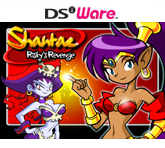
Shantae: Risky's Revenge is a platform video game developed by WayForward Technologies for the Nintendo DSi. The second installment in the Shantae series, Risky's Revenge is the sequel to the 2002 Game Boy Color video game Shantae, and follows series protagonist Shantae as she sets out to stop the ambitions of the nefarious pirate Risky Boots.
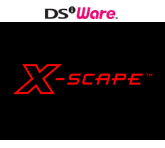
X-Scape, known as X-Returns in Japan and as 3D Space Tank in the PAL region, is a first-person combat simulation game developed by Q-Games and Nintendo released on the Nintendo DSi's DSiWare download service. It is a sequel to the 1992 Japan only Game Boy title X.

Art Academy, also known as Art Academy: Learn painting and drawing techniques with step-by-step training in the PAL regions and Artistic Taste Classroom DS in Japan, is an art training software for the Nintendo DS. It was developed by Headstrong Games and published by Nintendo. Art Academy was originally a two-part training application only available for download via the DSiWare service since 2009. It was later re-released in 2010 as a fully compiled, retail-able DS Game Card with added features, thus also making it available for original Nintendo DS and Nintendo DS Lite users.

The Oregon Trail is a strategy video game developed by Gameloft New York and Gameloft Shanghai and published by Gameloft. It was released for Java ME-based mobile phones in 2009; a high-definition version was later released for iOS the same year. The game was then ported to DSiware, followed by a number of other mobile operating systems and devices. The game was followed by two sequels: The Oregon Trail: Gold Rush and The Oregon Trail: American Settler.
















